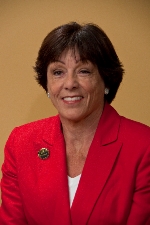
The New National Standards in Safe Patient Handling and Mobility
Aiming to improve the safety of patients, nurses and other health care workers, the American Nurses Association (ANA), in collaboration with a national working group and other professional organizations, has released “Safe Patient Handling and Mobility: Interprofessional National Standards,” a 40-page outline of eight evidence-based standards to prevent injury.

The ANA’s Karen A. Daley, PhD, RN, FAAN, said safe patient handling and mobility requires a culture of safety as the standard way of doing business.
“These standards set an important foundation for establishing a culture of safety all workers and patients deserve,” said Karen A. Daley, PhD, RN, FAAN, president of ANA, during a teleconference.
Daley reported that nurses lift the equivalent of about 1.8 tons in an eight-hour shift. Most injuries are a result of cumulative effects. Registered nurses suffered 12,000 musculoskeletal injuries resulting in missed workdays in 2011, and nursing assistants experienced the highest rate of such injuries at 25,000--more than any other occupation, including mining, manufacturing and construction, according to data from the U.S. Bureau of Labor Statistics. Such injuries prompt many professionals to leave patient care.
“We cannot afford these losses and still meet the rising demand for health care services,” Daley said. “We aim to make those days a thing of the past. A safe work environment means healthier workers and a higher quality of care for patients. These standards provide a blueprint for creating an essential culture of safety. We anticipate they will be widely embraced and adopted.”
An interprofessional working group established the standards, which are intended for use in any health care setting, including home care, by any professional or paraprofessional delivering the care. Mary Matz, MSPH, CPE, CSPHP, chaired the Safe Patient Handling and Mobility (SPHM) Working Group and is the national program manager for patient care ergonomics at the Veterans Health Administration.
“Creating a safe patient care work environment is much more complex than simply providing technology to caregivers and presuming they’ll use it,” Matz said. “To address such complexity, we brought together an array of professionals from a variety of settings along with their differing perspectives and expertise to collectively develop standards that work for patients and health care professionals in all patient care settings.”
The first standard calls for establishing a culture of safety, which includes ensuring safe levels of staffing, creating a nonpunitive environment, and developing a system for communication and collaboration.
The other standards include: implementing and sustaining a safe patient handling and mobility program; incorporating ergonomic design principles to provide a safe environment of care; selecting, installing and maintaining safe patient handling technology; establishing a system for education, training and maintaining competence; integrating patient-centered assessment, care planning and technology; including safe patient handling in reasonable accommodations and post-injury return to work policies; and establishing a comprehensive evaluation system. The book also includes a glossary and appendices with tools and resources.
“These standards will change the way health care is delivered, and it’s about time,” said Suzy Harrington, DNP, MCHES, RN, director of ANA’s Center for Occupational and Environmental Health.
Ronda Fritz, MA, BSN, RN, safe patient handling facility champion at the VA Nebraska-Western Iowa Health Care System in Omaha, reported on the huge difference a comprehensive program can have on preventing injuries to patients and care providers. The VA uses lifts, slings and other equipment to move patients, rather than dragging them across the sheets, which can result in shear injuries to patients. She indicated using the equipment also preserves the patient’s dignity and comfort, increases compliance with turning and repositioning schedules, and is more time efficient.
“The benefits to our staff from our safe patient handling program are amazing,” Fritz said, explaining their quality of life is better. Employees do not go home sore or injured.
Bob Williamson, RN, BSN, CSPHP, CWCP, director of associate safety for Ascension Health in St. Louis and president of the Association of Safe Patient Handling Professionals, made the business case for a comprehensive safe patient handling program, explaining such injuries result in 25 percent of all workers’ compensation claims in health care, with an average of $12,000 for each event.
“We know resources spent caring for these injuries is great,” Williamson said. “The value in an investment should be related to the business case, but we cannot just think of the financial. The business case includes the activities’ contribution to achieving the organization’s mission, vision, values or the work or activity that lead to the caregivers’ satisfaction and to the bottom line.”
Williamson said he felt adopting and adhering to the evidence-based standards will reduce injuries.
Lower-cost technology--lifting and transfer equipment--is available for all settings, including home health care, where family caregivers can benefit as well as professionals.
At this time, the standards are voluntary, but Harrington indicated that ANA is working with regulators and lawmakers in hopes of making the standards required by law.
The 8 Evidence-based Standards for Safe Patient Handling
1. Establishing a culture of safety, which includes ensuring safe levels of staffing, creating a nonpunitive environment, and developing a system for communication and collaboration.
2. Implementing and sustaining a safe patient handling and mobility program;
3. Incorporating ergonomic design principles to provide a safe environment of care;
4. Selecting, installing and maintaining safe patient handling technology;
5. Establishing a system for education, training and maintaining competence;
6. Integrating patient-centered assessment, care planning and technology;
7. Including safe patient handling in reasonable accommodations and post-injury return to work policies; and
8. Establishing a comprehensive evaluation system.
© 2013. AMN Healthcare, Inc. All Rights Reserved.


